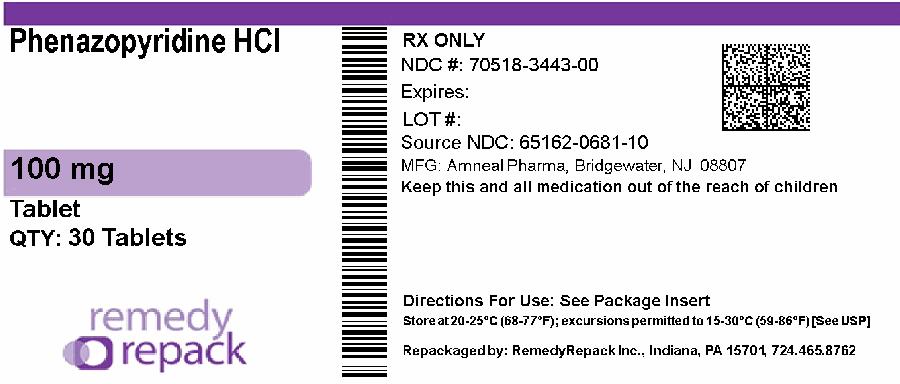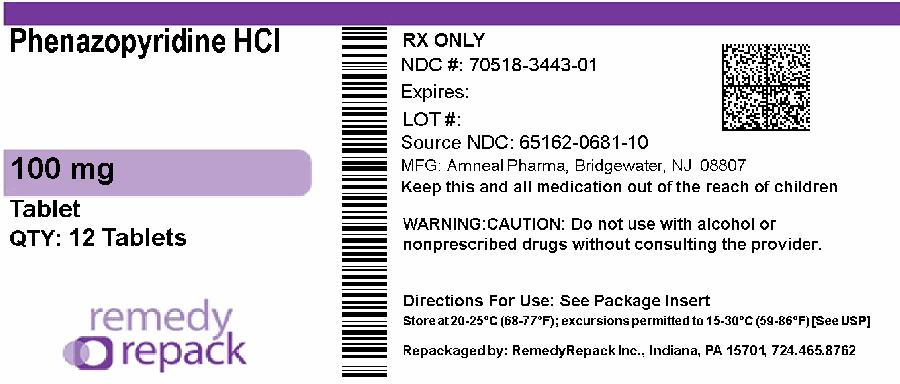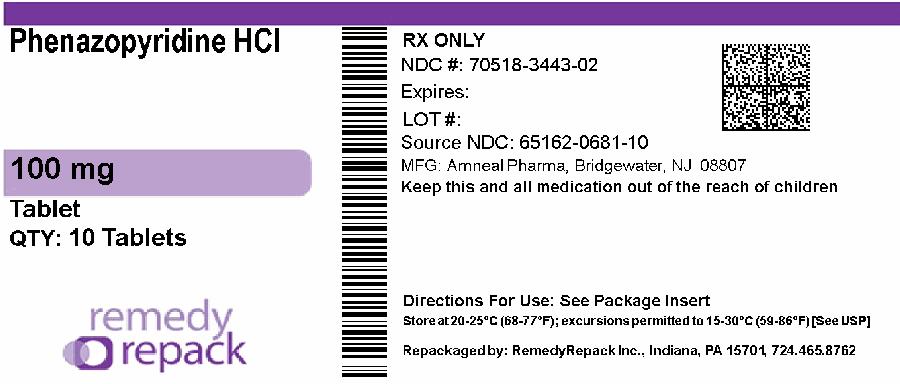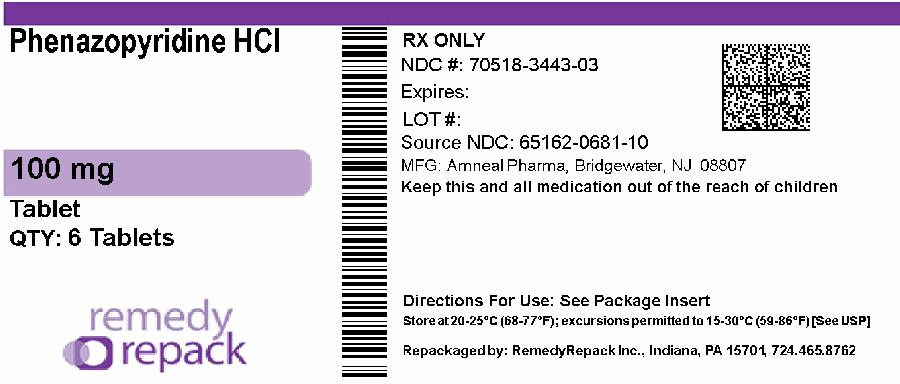Products1
Detailed information about drug products covered under this FDA approval, including NDC codes, dosage forms, ingredients, and administration routes.
Phenazopyridine Hydrochloride
Product Details
Drug Labeling Information
Complete FDA-approved labeling information including indications, dosage, warnings, contraindications, and other essential prescribing details.
PACKAGE LABEL.PRINCIPAL DISPLAY PANEL
PRINCIPAL DISPLAY PANEL
DRUG: Phenazopyridine Hydrochloride
GENERIC: Phenazopyridine
DOSAGE: TABLET
ADMINSTRATION: ORAL
NDC: 70518-3443-0
NDC: 70518-3443-1
NDC: 70518-3443-2
NDC: 70518-3443-3
COLOR: brown
SHAPE: ROUND
SCORE: No score
SIZE: 10 mm
IMPRINT: PY;1
PACKAGING: 30 in 1 BLISTER PACK
PACKAGING: 12 in 1 BOTTLE PLASTIC
PACKAGING: 10 in 1 BOTTLE PLASTIC
PACKAGING: 6 in 1 BOTTLE PLASTIC
ACTIVE INGREDIENT(S):
- PHENAZOPYRIDINE HYDROCHLORIDE 100mg in 1
INACTIVE INGREDIENT(S):
- CARNAUBA WAX
- CROSCARMELLOSE SODIUM
- HYPROMELLOSES
- MAGNESIUM STEARATE
- CELLULOSE, MICROCRYSTALLINE
- POLYETHYLENE GLYCOL 1000
- POVIDONE
- STARCH, CORN




DESCRIPTION SECTION
DESCRIPTION
Phenazopyridine Hydrochloride, USP is light or dark red to dark violet, odorless, slightly bitter, crystalline powder. It has a specific local analgesic effect in the urinary tract, promptly relieving burning and pain. It has the following structural formula:

C 11H 11N 5•HCl M.W. 249.70
Phenazopyridine HCl tablets, USP contain the following inactive ingredients: carnauba wax, croscarmellose sodium, hypromellose, magnesium stearate, microcrystalline cellulose, polyethylene glycol, povidone, pregelatinized starch.
CLINICAL PHARMACOLOGY SECTION
CLINICAL PHARMACOLOGY
Phenazopyridine HCl is excreted in the urine where it exerts a topical analgesic effect on the mucosa of the urinary tract. This action helps to relieve pain, burning, urgency and frequency. The precise mechanism of action is not known.
The pharmacokinetic properties of Phenazopyridine HCl have not been determined. Phenazopyridine HCl is rapidly excreted by the kidneys, with as much as 66% of an oral dose being excreted unchanged in the urine.
INDICATIONS & USAGE SECTION
INDICATIONS AND USAGE
Phenazopyridine HCl is indicated for the symptomatic relief of pain, burning, urgency, frequency, and other discomforts arising from irritation of the lower urinary tract mucosa caused by infection, trauma, surgery, endoscopic procedures, or the passage of sounds or catheters. The use of Phenazopyridine HCl for relief of symptoms should not delay definitive diagnosis and treatment of causative conditions. Because it provides only symptomatic relief, prompt appropriate treatment of the cause of pain must be instituted and Phenazopyridine HCl should be discontinued when symptoms are controlled.
The analgesic action may reduce or eliminate the need for systemic analgesics or narcotics. It is, however, compatible with antibacterial therapy and can help to relieve pain and discomfort during the interval before antibacterial therapy controls the infection. Treatment of a urinary tract infection with Phenazopyridine HCl should not exceed 2 days because there is a lack of evidence that the combined administration of Phenazopyridine HCl and an antibacterial provides greater benefit than administration of the antibacterial alone after 2 days (seeDOSAGE AND ADMINISTRATION section).
DOSAGE & ADMINISTRATION SECTION
DOSAGE AND ADMINISTRATION
100 mg Tablets: Average adult dosage is two tablets 3 times a day after meals.
200 mg Tablets: Average adult dosage is one tablet 3 times a day after meals.
When used concomitantly with an antibacterial agent for the treatment of a urinary tract infection, the administration of Phenazopyridine HCl should not exceed 2 days.
CONTRAINDICATIONS SECTION
CONTRAINDICATIONS
Phenazopyridine HCl should not be used in patients who have previously exhibited hypersensitivity to it. The use of Phenazopyridine HCl is contraindicated in patients with renal insufficiency.
ADVERSE REACTIONS SECTION
ADVERSE REACTIONS
Headache, rash, pruritus and occasional gastrointestinal disturbance. An anaphylactoid-like reaction has been described. Methemoglobinemia, hemolytic anemia, renal and hepatic toxicity have been reported, usually at overdosage levels (seeOVERDOSAGE section).
To report SUSPECTED ADVERSE REACTIONS, contact Amneal Pharmaceuticals at 1-877-835-5472 or FDA at 1-800-FDA-1088 or www.fda.gov/medwatch.
OVERDOSAGE SECTION
OVERDOSAGE
Exceeding the recommended dose in patients with good renal function or administering the usual dose to patients with impaired renal function (common in elderly patients) may lead to increased serum levels and toxic reactions. Methemoglobinemia generally follows a massive, acute overdose. Methylene blue, 1 to 2 mg/kg/body weight intravenously or ascorbic acid 100 to 200 mg given orally should cause prompt reduction of the methemoglobinemia and disappearance of the cyanosis which is an aid in diagnosis. Oxidative Heinz body hemolytic anemia may also occur, and “bite cells” (degmacytes) may be present in a chronic overdosage situation. Red blood cell G-6-PD deficiency may predispose to hemolysis. Renal and hepatic impairment and occasional failure, usually due to hypersensitivity, may also occur.
HOW SUPPLIED SECTION
Phenazopyridine HCl tablets, USP 100 mg are available as deep brown to maroon colored, round, film-coated tablets debossed “PY” above “1” on one side and plain on the other.
They are supplied as follows:
NDC: 70518-3443-00
NDC: 70518-3443-01
NDC: 70518-3443-02
NDC: 70518-3443-03
PACKAGING: 30 in 1 BLISTER PACK
PACKAGING: 12 in 1 BOTTLE PLASTIC
PACKAGING: 10 in 1 BOTTLE PLASTIC
PACKAGING: 6 in 1 BOTTLE PLASTIC
DISPENSE contents with a child-resistant closure (as required) and in a tight container as defined in the USP.
STORE at 20° to 25°C (68° to 77°F); excursions permitted between15° to 30°C (59° to 86°F) [see USP Controlled Room Temperature].
Repackaged and Distributed By:
Remedy Repack, Inc.
625 Kolter Dr. Suite #4 Indiana, PA 1-724-465-8762
SPL UNCLASSIFIED SECTION
**CAUTION:**Federal law prohibits dispensing without prescription.
